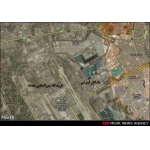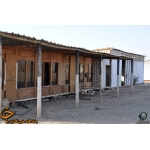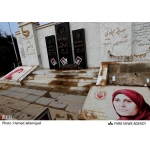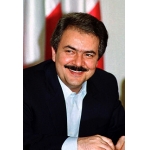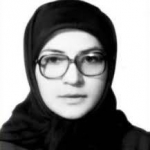Camp Ashraf
Laila Heydari Bateni
321 بازدید
Camp Ashraf was the central headquarters of the Mojahedin Khalq Organization (MKO) from 1987 to 2012. Their operations during the final years of the Iran-Iraq war were commanded from this camp.
After the MKO’s defeat in their armed struggle against the Islamic Republic in 1981, the leader of the organization, Massoud Rajavi, fled. He first went to France, but in 1986 the French government expelled him for disregarding domestic and security laws. He then fled to Iraq.[1] In 1987, Camp Ashraf was donated to him by Saddam. After the start of the imposed war in 1980, the organization, as the fifth pillar of the Iraqi army, engaged in an armed war against Iran and took responsibility for specific operations.[2]
Camp Ashraf was established in the winter of 1987 in a place called "Khalis", which was an abandoned military base of the Iraqi army. This 24,000-meter plot of land is located 20 km north of the city of Khalis in Iraq's Diyala province, 100 km northeast of Baghdad on the Kirkuk-Baghdad Road, and 80 km from the Iraq-Iran border in Kermanshah Province. Under the command of Massoud Rajavi, this camp became the largest headquarters of the MKO.
After settling in the camp and forming the Liberation Army (consisting of approximately 5,000 soldiers[3]) the organization assisted the Ba'athist government in operations inside Iran and in controlling foreign forces from Iran, It became a secondary headquarters (after Maryam Rajavi's camp in France).[4] Therefore, it intensified the quantity and quality of its operations and was able to capture a number of Iranian forces in several operations in the areas bordering the south and west of Iran.[5]
Massoud Rajavi commanded the operations, while all meetings, lectures, preparations for the operations, military training, maneuvers, mapping of roads, etc. took place within Camp Ashraf.[6] It also contained ammunition depots which held heavy and medium cannons, tanks and a variety of small arms, light weapons and explosives. This was all blown up by American forces in 2003.[7]
To compensate for the lack of manpower in operations, Rajavi turned to the Iranian prisoners of war. "We have solved the problem of our force by using prisoners of war," he once said in a meeting.[8] The organization forced Iranian prisoners to join the organization by promising their release or by exerting psychological pressure and threats. The situation between the prisoners who were from the Iranian army and those who were Basij was very different, with the Basij being treated stricter and harsher.[9]
This camp was also the main training, support and operational base of the organization. The camp’s personnel department, under the supervision of Fahimeh Arvani, managed several of the camp’s prisons.[10] Among its prisons mentioned can be made of: The Guest House or 100 Prison (located on 100th Street, overlooking the camp’s entrance). Prisons known as M1, M2 and M3. Prison near Center 12, which was surrounded by barbed wire. The East Side Prison with tall cement walls. Prison 37 (located on 37th Street, which held Iranian prisoners of war). Dreadful Prison (located on the east side, consisting of eight buildings). This prison was one of the most dreadful prisons in the camp and was surrounded by towers up to 3m high, which were wrapped in barbed wire and illuminated at night with powerful light projectors. Reception Prison (south of the camp and reserved for members of the organization). Faculty Prison Forough (north of the garrisons and for dissidents).[11] Prison 400 (located on 400th Street and for members who wanted to leave the organization).[12] Among the camp’s guards were Omid Boroumand, the operations officer, Batool Rajaei, the camp commander and Hassan Hassanzadeh.[13]
In fact, the camp, from the outside, was considered the organizational, military, political, propaganda and financial headquarters, but from within, it was a base for controlling the ideology of the forces. It was named after Ashraf Rabiee, the first wife of Massoud Rajavi, who was killed during an operation to seize the headquarters of the MKO in the Zafaranieh area of Tehran on February 10, 1982.[14]
Camp Ashraf was divided into several sections, the main one being protected by barbed wire, physical barriers and armed guards: 1- Temporary houses and meeting hall (with two temporary houses for Rajavi) 2- Fixed house of the headquarters (Rajavi's main house) 3- Palace and anti-bomb shelter on 100th Street (Rajavi and his wife's house).[15]
All the streets of the camp were numbered, and 100th Street was the largest and widest street.[16] The members of the organization's counter-intelligence unit, as well as newcomers to the organization from Europe, settled in the area of the camp called the "entrance". This area had modern and well-equipped houses and green areas, making one feel that the further they go, the better the conditions and environment will be.[17]
In addition to the numerous buildings, the camp had a hospital, an amphitheater, a library, a number of large dining halls, and a cemetery called the Pearl Piece.[18] The cemetery was located in the eastern part of the camp, and a monument was erected for three members of the organization who were killed by Iraqi Shiites with swords. Maryam Rajavi's mother was also buried in this cemetery.[19]
Camp Ashraf was financially dependent on Iraq, and the cost of repairing its various equipment was paid for through government assistance.[20]
In the years 1996-1997, the organization tried to recruit forces by deceiving Iranians who entered Turkey for various reasons and also by kidnapping.[21]
In 2002, due to the sensitive situation in Iraq, all the bases of the MKO in the central cities of Iraq were closed and their forces were transferred to Camp Ashraf.[22]
After the presence of American forces in Iraq, the camp also came under their control. The organization also opened Ashraf Park for the Americans' entertainment and parties, as well as a number of new stores.[23] Since then, the organization changed the name of the camp to Ashraf.[24] There was a headquarters in the camp that was in charge of private cars, trucks and trailers. After the arrival of the American forces, the organization handed over the vehicles to the heads of the Iraqi tribes and trustees so that they would not fall into their hands, and be given back at the appropriate time.[25]
After the fall of Saddam in 2003, the US military disarmed members of the organization, and in 2008 the Iraqi government was given authority over Camp Ashraf. The government also took over the security file of it from the US military in 2009 and made the expulsion of its members a priority. Since then, according to the US plan, the residents of Camp Ashraf have been transferred to the Liberty Military Base near Baghdad Airport.[26] The last group of the organization, except for a few of them, left Camp Ashraf on September 17, 2012. This camp was completely destroyed by a group called Shabanieh Intifada in September 2013.[27]
[1] Rastgoo, A, A., Mojahedin Khalq in the Mirror of History, Tehran: Islamic Revolutionary Documentation Center, 2005, p.222.
[2] Haqbin, M., From the Mojahedin to the Hypocrites, Tehran: Islamic Revolutionary Documentation Cente r, 2013, p. 339; Rastgoo, Ali Akbar, Mojahedin Khalq in the Mirror of History, p. 259.
[3] Rastgoo, A. A., Mojahedin Khalq in the Mirror of History, p. 230.
[4] Khodabandeh, E., One person one day for thirty years, Tehran: Jam Jam Institute, 2013, p. 343.
[5] Mojahedin Khalq Organization of Appearance to Fate, by a collective effort of researchers, Vol. 3, Institute of Political Studies and Research, 2006, pp. 285-283.
[6] Rastgoo, A. A., Mojahedin Khalq in the Mirror of History, p. 229.
[7] Seyyed. I., Seyyed, H., God Ashraf from Rise to Fall, Tehran: Islamic Revolution Documentation Center, 2014, pp. 846 and 847.
[8] Asgari, S., War in Captivity, Tehran: Organization for the Preservation of Relics and Publication of the Values of the Sacred Defense of the Army of the Islamic Republic, 2012, p.99.
[9] Rastgoo, A. A., Mojahedin Khalq in the Mirror of History, p. 227.
[10] Ibid, P. 375.
[11] Tabraian, S., Sleepwalkers, Tehran: Islamic Revolutionary Documentation Center, 2013, pp. 109 and 110.
[12] Rastgoo, A. A., Mojahedin Khalq in Aibneh Tarikh, pp. 379-375.
[13] Ibid, P. 382.
[14] Khodabandeh, I., One person one day thirty years, p. 344.
[15] Haqbin, M., From the Mojahedin to the Hypocrites, Tehran: Islamic Revolutionary Documentation Center, 2013, p.339.
[16] Seyyed Ismaili, Seyyed Hojjat, God of Ashraf from emergence to fall, pp. 912 and 913.
[17] Derakhshan, Parviz, My Story with the Mojahedin Khalq, Tehran: Islamic Revolutionary Documentation Center, 2011, p.123
[18] Ibid, P. 30.
[19] Ibid, P.55.
[20]Tabraian, Safa al-Din, Sleepwalkers, p. 388.
[21] Seyyed Ismaili, Seyyed Hojjat, God of Ashraf from emergence to fall, p. 856.
[22] Ibid, P. 816.
[23] Ibid, P. 849.
[24] Ibid, P. 854.
[25] Ibid, P. 870.
[26] Haqbin, Mehdi, from the Mujahideen to the hypocrites, pp. 339-341 ..
[27] Seyyed Ismaili, Seyyed Hojjat, God Ashraf from Rise to Fall, pp. 875, 891 and 881



